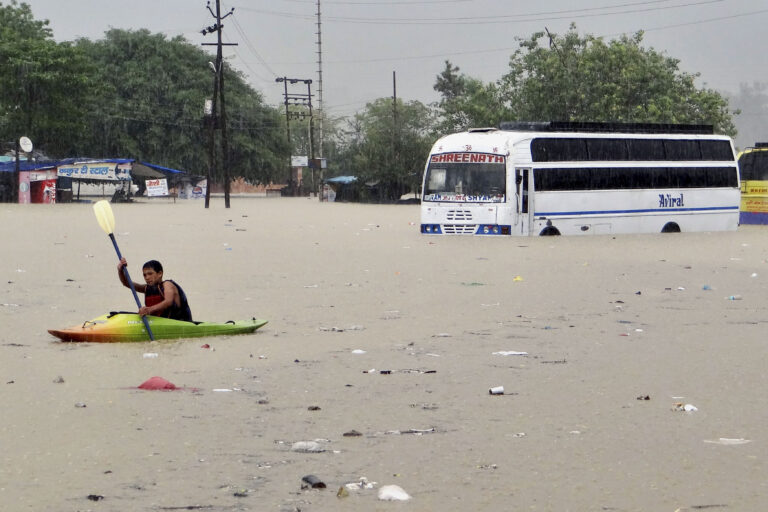- Bichhri village in Rajasthan’s Udaipur district is facing water scarcity and contamination for over 35 years following pollution caused by fertiliser and acid manufacturing factories.
- The contamination has not only impacted drinking water availability but has also significantly affected the village’s agricultural yields and livestock productivity, the residents claim.
- The polluting factories completely stopped operations after a 1996 Supreme Court order, but the implementation of the order has not been effective claim the residents, who are still waiting for promised compensation and clean water.
Strolling on the streets of Bichhri village, one sees water containers of all sizes kept outside or hung on the windows of most houses. One such house, half-built, covered with a tin shed, along the main road entering this village in Rajasthan, belongs to Lehri Devi, a 50-year-old tribal woman. “We are always on the lookout for water,” she says while arranging water-filled containers in her courtyard.
“He knows it,” she says, pointing towards her 16-year-old grandson, who has just returned from school. “If the tanker stops here, he rushes to fill water.” Most people in Bichhri spend a significant amount of their time filling and fetching water, she says.
Visibly tired of narrating the same-old story of Bichhri, Lehri Devi explains how it all started. She was then a young bride who had just moved to the village. “When I got married and came to this village, people could grow a wide variety of crops. But then the factory started and it all suddenly stopped.”
Lehri Devi is referring to the year 1987 when five chemical factories were set up by an industrialist, O.P. Agarwal, on the hillocks near the village. The factories used to manufacture various chemicals, primarily fertilisers, with some manufacturing acids such oleum and H-acid. Manufacturing H-acid, a dye intermediate, releases toxic iron-based sludge and gypsum-based sludge. The wastewater generated from manufacturing H-acid is acidic and contains a high concentration of dissolved solids along with pollutants.
The factories would release the acidic, dark tan effluents into an open drain that ran across Bichhri, emptying into the Udaisagar canal.
A large quantity of this effluent also seeped into the ground through the unlined pits, contaminating the groundwater and turning it a dark colour.

“This water was being released into the ground. They did not build any treatment plant. I saw it myself. They were dumping the effluents in open fields or directly into the ground by digging deep pits,” says Chunni Lal, a farmer and a former employee at Hindustan Agro Limited, one of the factories that released harmful chemicals.
Two of the five factories, Jyoti Chemicals and Silver Chemicals, that produced H-acid, were operating for about a year, before they were closed, generating about 8250 cubic metre of wastewater water and over 2400-2500 MT of highly toxic sludge, besides other pollutants.
Impact on agriculture
The sound of the coming water tanker sets the entire street into chaos. “They send the tanker, but it is not enough. How do we do everything with it?” says Lehri Devi about the water tanker that the neighbouring Hindustan Zinc, whose name appears in Supreme Court proceedings, sends as a Corporate Social Responsibility (CSR) initiative. Mongabay India has reached out for a comment, via email, to Hindustan Zinc and has not received a response at the time of publishing.
The issue of Bichhri is not limited to the dearth of drinking water. Over the years, toxic sludge and wastewater leaching into the groundwater has contaminated soil, severely impacting farm yield.
“We used to get 20 jute bags of wheat out of this farm. Now, it is reduced to just five jute bags. Only five jute bags in this two bigha (1.25 acre) farm,” Lehri Devi says, pointing towards her farm. “There are nine people [in my family] and four cattle. What do we eat? Do we buy wheat?” she asks.
Once an agrarian village, popular for its sugarcane and wheat cultivation, the land in Bichhri hardly yields anything now, say the farmers there. “We can’t grow sugarcane now. Sometimes, the wheat crop suddenly stops growing, resulting in zero yields,” says Chunni Lal, who attributes it to the contamination from the factories. With the soil becoming contaminated and agriculture becoming affected, some people have migrated from the village, leaving their barren lands behind.

Omkar Gaonkar, a researcher at Toxics Link, an NGO working on chemicals and waste-related issues for over 20 years, says, “The possible toxins can be iron and calcium oxide (in excess amounts) because iron sludge and gypsum are produced during the H-acid production.” He explains that if the soil has more salts (produced during H-acid production), the soil salinity will change, directly impacting the plant’s yield.
Along with the impact on agriculture some local residents suspect that the contaminated environment is also impacting cattle and thus, milk productivity.
Dudharam, a local veterinarian, validates their suspicion saying, “In Bichhri, if you bring a cow or buffalo from outside within one year, its milk productivity almost halves.” He, however, emphasised that a more in-depth study should be conducted before reaching any conclusion about the impact of contamination on cattle.
Waiting for justice
Jyoti Chemicals and Silver Chemicals began producing H-acid in April 1987 and February 1988 respectively. Locals noticed a change in water quality starting July and August 1988. They began protests and wrote to various political leaders and the then Sub-Divisional Magistrate (SDM), who initiated an inquiry. In September 1988, SDM Girwa Udaipur initiated action under Section 133 and in March 1989, two plants, Jyoti Chemicals and Silver Chemicals, ceased operations. In the same month, a lawyer and activist named Mannaram Dangi filed an affidavit against O.P. Agarwal in the Sub-Divisional Magistrate (SDM) court. Later, in August 1989, he filed a petition in the Supreme Court (SC).
A court battle ensued, continuing till 1996, when the apex court gave its first verdict. The Supreme Court ordered the shutting down all five factories including the two producing H-acid plants, Jyoti Chemicals and Silver Chemicals, which were already shut in 1989 after months of operation.
The order directed that the “rogue industries” have inflicted untold misery upon the village residents, impacting their land, water sources and the environment – all in pursuance of their private profit.
Over 35 years after the 1989 closure of the plants, the aftereffects remain.
Polluter pays principle applied for the first time
In the Bichhri case, also known as the Indian Council of Enviro-Legal Action vs. Union of India 1996, Justice Dalveer Bhandari declared that reversing the imbalance caused to the ecology is part of the industrial process. Thus, the financial responsibility of prevention and controlling the pollution caused should rest upon the industry which caused pollution. The Bichhri court judgment became the pioneering case where the ‘polluter pays principle’ – which notes that the polluter is liable for environmental pollution and needs to pay for damages – was applied and defined for the first time.
In line with the ‘polluter pays principle’ and the doctrine of Absolute liability, the court directed offending industries to pay Rs. 373.85 million for the remediation of impacted water wells.

On the questions of individual damages to the villagers, the judgment asked the impacted villagers to file a civil suit. Following the judgment, some 160 affected families registered a trust and filed Rs. 280 million worth of compensation claims to the court.
“To claim the damages, we filed a suit in Udaipur Civil court. The case is still going on. Until now we have not had any kind of relief,” said Chunni Lal on the compensation status.
Mannaram Dangi, the Udaipur-based lawyer who filed the petition in the Bichhri case, said, “The judgment failed in its motive and implementation.” He adds that the villagers happy with the judgement, but the interim relief in terms of immediate monetary relief for the damage caused to the fields, crops, and cattle, which should have been given to the villagers, was not given by the Supreme Court.
He added, “Along with the seizure of the factories, the 1996 Supreme Court judgment also ordered for providing safe drinking water to the affected villages.” He adds, “This part of the judgment was implemented but the court order on recovering the remediation money was never met.”
In 2011, as the SC reinstated the 1996 judgment in the Bichhri case, Justice Dalveer Bhandari noted, “This is a very unusual and extraordinary litigation where even after fifteen years of the final judgment of this court (February 13 1996) the litigation has been deliberately kept alive by filing one interlocutory application or the other to avoid compliance of the judgment.” The court said that the 1996 judgment had not been permitted to acquire finality till date. “This is a classic example of how by abuse of the process of law, even the final judgment of the apex court can be circumvented for more than a decade and a half,” Bhandari noted.
The long wait has made the village residents passive and disinterested in the issue, they say.
“One pertinent reason for people to lose interest is that they never received any direct (monetary) incentive,” Dangi added. He asserts that it is the government’s responsibility because the Ministry of Environment (MoE) is the trustee of the common people. Common people can’t restore soil and water; it needs expertise. Also, money for restoration has to be recovered by the MoE, he said.
“Who will recover the money and use it for restoration? This responsibility lies with the MoE. But the judgment did not mandate this,” Dangi said.
Mongabay-India reached out to Leena Nandan, Secretary for the Ministry of Environment, Forest and Climate Change, and Tara Chand Meena, Udaipur district collector, on remedial measures, compensation amount and any soil and water restoration efforts by the government but did not receive a response at the time of publishing. Tara Chand Meena was replaced by Arvind K. Poswal on July 14. Questions were sent to him too but elicited no response.
Read more: Depleting groundwater makes it difficult for Rajasthan farmers to use solar pumps
Banner image: Bichhri residents fill water from the tanker. Photo by Shiva Singh.













